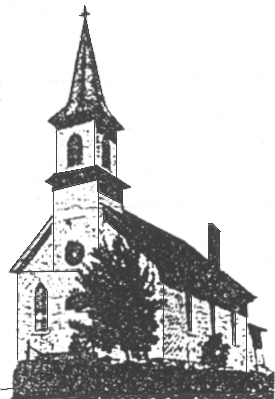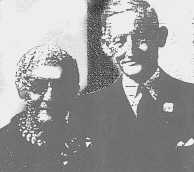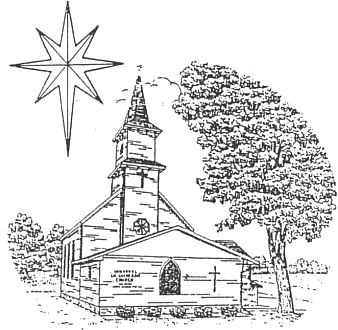
GLOBE IMMANUEL LUTHERAN CHURCH
Weston Township, Clark Co., WI

In 1899 this building succeeded a log structure.
History of Globe Immanuel Lutheran
Source: Immanuel Lutheran Church Centennial Booklet
Contributed by: Lois Hagedorn
The congregation of Immanuel, Globe, was formed June 24, 1882. The members built a log church in 1885. As the congregation grew, it was decided to build our present church in 1898. Land was acquired from William Scheel. The log church would be used as a schoolhouse.
Members pledged to donate labor and materials for the building of the new church. Thirty-seven members signed the pledge. The building committee consisted of : Fred Kalsow, Fred Steinberg, Wm. Kuhl and W. B. Thoma.
Mr. Fibke, brother-in-law of Pastor Thrun, was given the contract to build the church in 1899, at a price of $400.00. The lumber was sawed at Merkel's Sawmill, which was situated at the Gale Lonning farm, across the road (next to the creek) from the Henry Thoma farm. There was also a small store located there.
Money was very scarce at this time, any amount that was donated was a great sacrifice. The church and religious training of the children was very important. Logging and turn-piking (road-building) were the main sources of income; dairy farming was just beginning. Wages were very meager; many people worked a full day for $.50.
Even though there was a shortage of money, a black and gold hanging was purchased for the altar and pulpit, as well as the first crucifix, in time for the building dedication in 1899.

G. E. Grap shown above helped to
build the old log church and was
married in it in 1890.
In 1900 the first pup organ was purchased, which was pumped with the feet. It was later used in the schoolhouse.
A log wood stove was purchased and was placed on the west side of the church about four pews from the back. The pipe ran the full length of the church to the chimney, located in back of the pulpit.
At the 20th anniversary of the church in 1907, the bell was dedicated to the Lord. The guest speaker for the anniversary said that when the bell rings, it says, "The Lord is here."
In 1907 the school was built and the first confirmation class of 24 was confirmed by Pastor Brandt.
In 1910, two dozen wooden folding chairs were purchased, and in 1911 metal paneling was installed on the inside walls of the church. The basement was dug in 1924. Frank Thoma's litter carrier was used to haul dirt out by erecting a pole by the schoolhouse and stringing a cable so that the carrier could ride on it. The wall wasn't sturdy under the church after the soil was removed, requiring a cement retaining wall for reinforcement. The wood furnace was also installed at this time.
In 1916, the parsonage was built on land purchased from Robert Mitte, a well was also dug. The carpenter was Albert Kalsow.
German services were held at this time. The first English service was held on Nov. 21, 1924, by Pator Parisius, even though it was difficult for him to speak English.
The Ladies' Aid purchased an organ in 1924, costing $944.00. The organ was quite large, had a double keyboard, full foot pedal, and pipes in the back to resemble a pipe organ. A large mirror was placed high on the pipes so the organist could see the altar. There was a crank on the side that had to be turned to pump air into it so it would play. That was usually the janitor's job. Later, a small electric motor was installed for that purpose. The organ was in the alcove of the balcony.
Three kerosene lamps on either side of the church were used for lighting until 1927, when two gas lamps were installed, as well as a large chandelier in the center, with 24 lamps and small chandeliers in the front and back of the church.
In 1935 the steeple was struck by lightning, also damaging the wainscoting on the west side.
Voting to install electricity in 1938 was voted down. The Ladies' Aid paid for the installation of electricity in the parsonage in 1940.
Twenty-five new blue hymnals were purchased at a cost of $.85 each in 1941. The same year, cement steps were placed on the font church entrance, as well as reshingling the parsonage.
On Jan. 11, 1942, it was voted to install electricity in the church and the schoolhouse.
Paul Klauer planted the cottonwood tree by the south entrance to the church in 1942, which was cut down Aug. 17, 1999.
The annual church report was implemented in 1945.
In 1946, the pulpit was moved to the side of the church, was lowered, and a door was built in the rectory, enabling entry tot he pulpit. Lightning rods were also installed on the roof.
September 4, 1949, the 50th anniversary was celebrated. The interior was redecorated for this occasion and the Ladies' Aid furnished new carpeting for the altar area.
An oil furnace was purchased in 1950 and a basement was dug on the north end.
In 1953 the ceiling was lowered, the tin was removed from the sides, tile was installed and fluorescent light, too.
The church roof was reshingled in 1956.
In 1957, German services were discontinued. A new oil furnace was purchased at this time.
The young people's society built and installed the hymnal racks.
In June & July of 1961 the schoolhouse was moved and connected onto the church, and a basement was constructed under it.
The move was done by Henry Marquardt. A new organ was purchased during this time.
A lighted cross was installed on the outside of the church in 1960, in memory of Herman Schoenherr.
The outdoor toilets were sold, a well was dug (by Ray Ditter), and bathrooms were installed in the basement. Cupboards were built by Harold Thoma.
The candleholders were stolen from the altar in 1969, and it was decided to keep the church locked from this point on. Saturday school began and a chapel-size organ was purchased.
In 1973, the congregation decided to join the Wisconsin Evangelical Lutheran Synod (WELS). A new entrance was built by Don Marg, costing $3600.00, and the parking lot was enlarged.
September 1974, the 75th anniversary of the church building was celebrated, a picture and address book of the membership was published for this occasion. The beautiful stained glass window was installed in the entry, in memory of Henrietta Mills.
A suspended ceiling was installed in 1978, as well as repairing the steeple and bell tower and closing the sides, resulting in the bell barely being audible. Therefore, it was partially opened in 1979, so that it could be heard.
Aluminum siding was put on the church and school by Kenny Schultz in 1980.
The Hammond organ was purchased in 1982, from a former music teacher in Withee. Sealed bids were accepted by the old organ and the original pump organ. Mrs. Lyman (Willetta) Heidemann submitted the highest bid for the electric organ and Dan Dux for the pump organ.
April 1985, the circular stained glass lights were installed; they were made by Pastor Norman Barenz of Hartland, WI. The fluorescent lights, which had been in the church, were then installed in the school.
In the early 1980's, the church was insulated by Bruce Henchen. It is not known when the carpet was installed and seat cushion put on the pews.
Glass stained windows were installed with memorial money from 1991 - 1995. The first window on the east side of the church depicts the birth of Our Savior, Immanuel, which means, "God with us."
The second window on the east depicts Jesus blessing the children. Baby Jesus grew to be a man and revealed himself as Savior of all people, represent by the four races on the children's window.
Jesus' suffering in gethsemane is shown in the window on the southwest side. The center window reminds us of Jesus' death on the cross for our sins.
The resurrection window shows the resurrection of Christ. The victorious banner reminds us that through Christ's life, suffering and death, we have victory.

IMMANUEL LUTHERAN CHURCH
Globe, Wisconsin
1882-1999
Although all these material things are important to us and the maintenance of our church, the most important thing is that God's Word was preached and taught in this house for many generations. This only by the Grace of our Lord!
We are thankful our forefathers were so farsighted as to see the importance of our spiritual life for many generations.
The Lord has blessed us by sending Christian men to preach and teach the young and old.
Pastors
F.J. Eppling, 1887 - 1890 (From Neillsville St. John's)
Christian Doeehler, 1890 - 1892 (From Neillsville St. John's)
F. Thrun, 1892 - 1904 (From Neillsville St. John's) - Pastor when present church was built
Herman Brandt, 1904 - 1916) (From Neillsville St. John's)
Wm. Parisius, 1916 - 1927
Waler Motzkus, 1927 - 1939
Adolph Schumann, 1939 - 1957
Robert Schlict, 1957 - 1960
Justus Reuge, 1960 - 1963
David Witte, 1963 - 1968
Robert Bitter, 1968 -1973
Ralph Stuebs, 1974 - 1985
Paul Reede, 1985 - 1996
Kevin Hanke, 1997 - Present
100th Anniversary: Oct 3, 1999
Pastors remarks
The Sept. 7, 1899 edition of the Clark County Press relates the building dedication at Globe with the following terse recap of the previous Sunday's events: "There was a large crowd in attendance at the dedication of the new Lutheran Church at Globe last Sunday (Sept. 4, 1899)." That was all that was said. But history was made.
I like history. My mind goes back in time 100 years to 1899, the end of the "Roaring Nineties." President William McKinley was president. The Panama Canal was still a dream. Vice President Teddy Roosevelt and his "Rough Riders" were recent history. Arizona and New Mexico statehoods were still 13 years away. Indian Chief Sitting Bull was dead for only 9 years. The Apache warrior Geronimo was still alive. Most of the thing that marked the 20th century were still unheard of: World War I, a world-wide depression, World War II, the space race, landing a man on the moon, the Cold War, the nuclear arms race. If you had mentioned even some of the changes that this century would bring, you would have been labeled "crazy" -- internal combustion engines making the family car possible and interstate travel common, personal computers, etc. Many people were saying back in 1899, "If God had wanted man to fly, He would have given him wings." Neillsville was 54 years old. Clark County was organized 45 years before, 1854. My, how things have changed in the last 100 years!
I also like church history. I think of another church dedication long before Globe's: The year was 966 B. C. The supplies laid up for use in the construction of this edifice of worship had now been fully pieced together. The man who had made the provisions for this temple was King David. The man who dedicated the building was Solomon, his son. In 1 Kings Chapter 8, Solomon stood before the altar of the Lord in front of the whole assembly of Israel and prays this prayer:
"O Lord, God of Israel, there is no God like you in heaven above or on earth below -- you who keep your convenant of love with your servants who continue wholeheartedly in your way. You have kept your promise to your servant David my father; with your mouth you have promised and with your hand you have fulfilled it -- as it is today….And may these words of mine, which I have prayed before the Lord, be near to the Lord our God day and night, that he may uphold the cause of his servant and the cause of his people Israel according to each day's need, so that all the peoples of the earth may know that the Lord is God and that there is no other. But your hearts must be fully committed to the Lord our God, to live by his decrees and obey his commands, as at this time." (1 Kings 8: 23 - 24, 59, 60)
On that day, 1 Kings 8 tells us, the priests had to withdraw from the Holy Place, the inner sanctuary of the temple, because the cloud of glory of the Lord, the "Shekinah" glory, filled the temple, and the priest could not perform their duties. (1 Kings 8: 10 - 11)
What a wondrous time to be a worshipper of the true God!
Think of all the changes that had taken place only 100 years later. The year is 866 B. C. The kingdom of Israel is split. Ahab is King in Israel in the city of Samaria in the north. Jehosaphat is King in Judah in the south. Elijah is prophet. The worship of Baal is widespread. Jezebel would make a better witch than a queen. There are only 7000 believers in the land of Israel in the northern kingdom. Times are not nearly as good as they were in the days of Solomon.
And yet, it was still a wondrous time to be a worshipper of the true God! … To see fire fall from God in Heaven at Mr. Carmel. To hear the people cry out in fear and Joy, "The Lord, he is God; the Lord, he is God." To be alive when God ended the three-year famine at the prayers of Elijah. To have your faith rekindled and strengthened by the works and wonders of God in your own time.
Where will Immanuel be 100 years from now? Only Almighty God knows, to be sure. As in the days of the "Roaring Nineties," I believe that some of the advancements our great-grandchildren will take for granted would amaze us. Who knows? A colony on the moon? Interplanetary travel? Mining Mars? Inter-stellar space travel? Solar or nuclear powered Cars? Farming the oceans? Only God Almighty, the Omniscient God knows. One thing is almost for sure: I think the next 100 years have some surprises in store for God's people. But one thing will remain the same. God our Lord. Our Savior Jesus Christ. Salvation in Him, by grace alone, through faith alone, as taught by the Scriptures alone. One hundred years from now, may the people who live in and around Globe, and who, by God's grace, may still call Immanuel Lutheran Church their spiritual home, say with us and our ancestors before us:
"It is still a wonderful time to be a worshipper of the true God!"
"Firsts" in the 100 Years
Marriage: Ferdinand Grap & Martha Kalsow
Baptism: William Kuhl
Burial: William Bunkow, Jan 1900
Confirmation Class: 24 members in 1907
Related Links
Church: Globe - 125th Anniversary (31 Oct. 2007)
Return to the Weston Twp. Main site
|
© Every submission is protected by the Digital Millennium Copyright Act of 1998.
Show your appreciation of this freely provided information by not copying it to any other site without our permission.
Become a Clark County History Buff
|
A site created and
maintained by the Clark County History Buffs
Webmasters: Leon Konieczny, Tanya Paschke, Janet & Stan Schwarze, James W. Sternitzky,
|